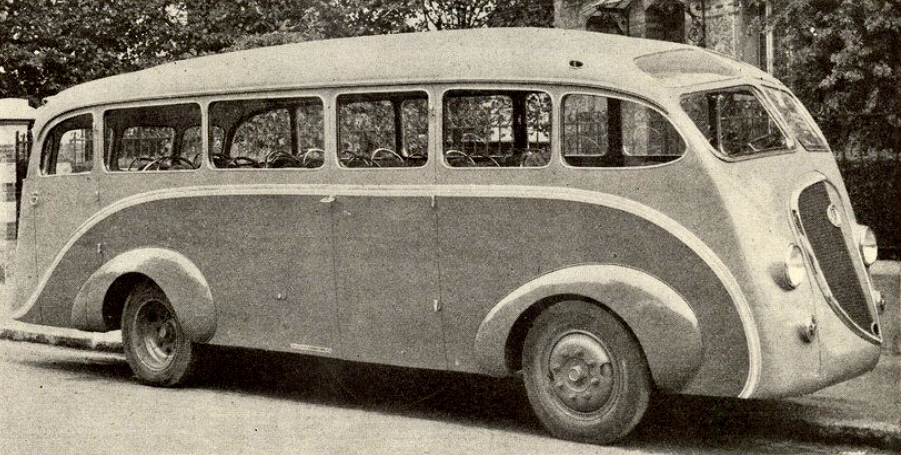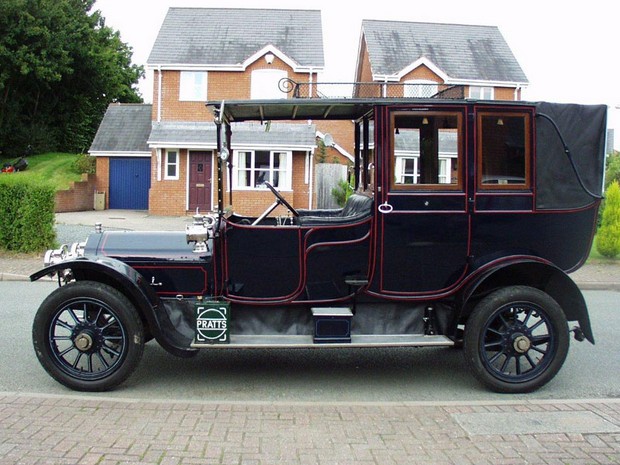|
Latil KTL
The Latil KTL is an all-wheel drive tractor produced by the French manufacturer Latil. It was used as a commercial as well as a military tractor. History The Latil KTL tractor was introduced in 1929. In October of that year, it was presented in the United Kingdom and, by early 1931, it was being imported into the country. By 1932, it started to be assembled locally under licence by the British company Shelvoke and Drewry with some minor modifications. From 1932 onwards, the KTL was tested by the French military as a replacement for the earlier Latil TL tractor for towing the canon de 105 mle 1913 Schneider, 105 L 13 canon, as the previous tractor was considered too slow. In 1934, The military finally commissioned the K TL4, a KTL with extended wheelbase, which was still slow for that usage. About 163 were built. In 1934, another KTL-based vehicle with extended wheelbase, the G TL3 prototype, was tested as a hauler for the Canon de 75 CA modèle 1940 Schneider, 75 CA anti-aircr ... [...More Info...] [...Related Items...] OR: [Wikipedia] [Google] [Baidu] |
Latil
Automobiles Industriels Latil, commonly known as Latil, was a French manufacturer of commercial and military vehicles created to manage the assets of the defunct Compagnie Française d'Mecánique et d'Automobiles, to market Georges Latil's , an early front-wheel drive system. The company was established in 1909 by entrepreneur Charles Blum as Charles Blum & Cie. It started to use in the 1910s as a trading name. The company started to produce military vehicles by the 1910s and commercial ones in great numbers by the end of World War I. In 1928, the company adopted its trading name as its legal name. It was dissolved in 1955 after being merged into the Saviem group. History Early years and predecessors In 1898, Georges Latil and Aloïs Korn established an enterprise in Marseille ( Korn et Latil) to market a Latil invention, the , a kit to convert carriages into front-wheel drive vehicles. In 1901, Latil and Korn moved its operations to Levallois-Perret and created the to sell i ... [...More Info...] [...Related Items...] OR: [Wikipedia] [Google] [Baidu] |
Millimetre
330px, Different lengths as in respect of the electromagnetic spectrum, measured by the metre and its derived scales. The microwave is between 1 metre to 1 millimetre. The millimetre (American and British English spelling differences#-re, -er, international spelling; International System of Units, SI unit symbol mm) or millimeter (American and British English spelling differences#-re, -er, American spelling) is a Units of measurement, unit of length in the International System of Units (SI), equal to one thousandth of a metre, which is the SI base unit of length. Therefore, there are one thousand millimetres in a metre, and there are ten millimetres in a centimetre. One millimetre is equal to micrometres or nanometres. Since an inch is officially defined as exactly 25.4 millimetres, a millimetre is equal to exactly (≈ 0.03937) of an inch. Definition Since 1983, the metre has been defined as "the length of the path travelled by light in vacuum during a time interval of ... [...More Info...] [...Related Items...] OR: [Wikipedia] [Google] [Baidu] |
Vehicles Introduced In 1929
A vehicle () is a machine designed for self-propulsion, usually to transport people, cargo, or both. The term "vehicle" typically refers to land vehicles such as human-powered vehicles (e.g. bicycles, tricycles, velomobiles), animal-powered transports (e.g. horse-drawn carriages/wagons, ox carts, dog sleds), motor vehicles (e.g. motorcycles, cars, trucks, buses, mobility scooters) and railed vehicles (trains, trams and monorails), but more broadly also includes cable transport ( cable cars and elevators), watercraft (ships, boats and underwater vehicles), amphibious vehicles (e.g. screw-propelled vehicles, hovercraft, seaplanes), aircraft (airplanes, helicopters, gliders and aerostats) and space vehicles (spacecraft, spaceplanes and launch vehicles). This article primarily concerns the more ubiquitous land vehicles, which can be broadly classified by the type of contact interface with the ground: wheels, tracks, rails or skis, as well as the non-contact technol ... [...More Info...] [...Related Items...] OR: [Wikipedia] [Google] [Baidu] |
Leaf Spring
A leaf spring is a simple form of spring (device), spring commonly used for suspension (vehicle), suspension in wheeled vehicles. Originally called a ''laminated'' or ''carriage spring'', and sometimes referred to as a semi-elliptical spring, elliptical spring, or cart spring, it is one of the oldest forms of vehicle suspension. A leaf spring is one or more narrow, arc-shaped, thin plates that are attached to the axle and chassis in a way that allows the leaf spring to flex vertically in response to irregularities in the road surface. Lateral leaf springs are the most commonly used arrangement, running the length of the vehicle and mounted perpendicular to the wheel axle, but numerous examples of transverse leaf springs exist as well. Leaf springs can serve multiple suspension functions: location, springing, and to some extent damping as well, through interleaf friction. However, this friction is not well controlled, resulting in stiction and irregular suspension motions. For t ... [...More Info...] [...Related Items...] OR: [Wikipedia] [Google] [Baidu] |
Drum Brake
A drum brake is a brake that uses friction caused by a set of Brake shoe, shoes or Brake pad, pads that press outward against a rotating bowl-shaped part called a brake drum. The term ''drum brake'' usually means a brake in which shoes press on the Brake lining, inner surface of the drum. When shoes press on the outside of the drum, it is usually called a ''Railway brake, clasp brake''. Where the drum is pinched between two shoes, similar to a conventional disc brake, it is sometimes called a ''pinch drum brake'', though such brakes are relatively rare. A related type called a band brake uses a flexible belt or "band" wrapping around the outside of a drum. History The modern automobile drum brake was first used in a car made by Wilhelm Maybach, Maybach in 1900, although the principle was only later patented in 1902 by Louis Renault (industrialist), Louis Renault. He used woven asbestos lining for the drum brake lining, as no alternative material dissipated heat more effectivel ... [...More Info...] [...Related Items...] OR: [Wikipedia] [Google] [Baidu] |
Four-wheel Steering
Steering is the control of the direction of motion or the components that enable its control. Steering is achieved through various arrangements, among them ailerons for airplanes, rudders for boats, cylic tilting of rotors for helicopters, and many more. Aircraft Aircraft flight control systems are normally steered when airborne by the use of ailerons, spoileron, or both to bank the aircraft into a turn; although the rudder can also be used to turn the aircraft, it is usually used to minimize adverse yaw, rather than as a means to directly cause the turn. On the ground, aircraft are generally steered at low speeds by turning the nosewheel or tailwheel (using a tiller or the rudder pedals) or through differential braking, and by the rudder at high speeds. Missiles, airships and large hovercraft are usually steered by a rudder, thrust vectoring, or both. Small sport hovercraft have similar rudders, but steer mostly by the pilot shifting their weight from side to side and unb ... [...More Info...] [...Related Items...] OR: [Wikipedia] [Google] [Baidu] |
Differential (mechanical Device)
A differential is a gear train with three drive shafts that has the property that the rotational speed of one shaft is the average of the speeds of the others. A common use of differentials is in motor vehicles, to allow the wheels at each end of a drive axle to rotate at different speeds while cornering. Other uses include clocks and analogue computers. Differentials can also provide a gear ratio between the input and output shafts (called the "axle ratio" or "diff ratio"). For example, many differentials in motor vehicles provide a gearing reduction by having fewer teeth on the pinion than the ring gear. History Milestones in the design or use of differentials include: * 100 BCE–70 BCE: The Antikythera mechanism has been dated to this period. It was discovered in 1902 on a shipwreck by sponge divers, and modern research suggests that it used a differential gear to determine the angle between the ecliptic positions of the Sun and Moon, and thus the phase of the Moon. ... [...More Info...] [...Related Items...] OR: [Wikipedia] [Google] [Baidu] |
Transfer Case
A transfer case is an intermediate gearbox that transfers power from the transmission of a motor vehicle to the driven axles of four-wheel-drive, all-wheel-drive, and other multi-axled on- and off-road machines. A part of the vehicle's drivetrain, it employs drive shafts to mechanically deliver motive power. The transfer case also synchronizes the difference between the rotation of the front and rear wheels (only high-speed 4wd-Awd systems), and may contain one or more sets of low range gears for off-road use. Functions The transfer gearbox (a secondary transmission system) receives power from the transmission and sends it to both the front and rear axles, or just one (usually the rear.) This can be done with gears, hydraulics, or chain drive. On some vehicles, such as four-wheel-drive trucks or vehicles intended for off-road use, this feature is controlled by the driver. The driver can put the transfer case into either "two-wheel-drive" or "four-wheel-drive" mode. Thi ... [...More Info...] [...Related Items...] OR: [Wikipedia] [Google] [Baidu] |
Manual Transmission
A manual transmission (MT), also known as manual gearbox, standard transmission (in Canadian English, Canada, British English, the United Kingdom and American English, the United States), or stick shift (in the United States), is a multi-speed motor vehicle Transmission (mechanical device), transmission system where gear changes require the driver to manually select the gears by operating a gear stick and clutch (which is usually a foot pedal for cars or a hand lever for motorcycles). Early automobiles used ''sliding-mesh'' manual transmissions with up to three forward gear ratios. Since the 1950s, ''constant-mesh'' manual transmissions have become increasingly commonplace, and the number of forward ratios has increased to 5-speed and 6-speed manual transmissions for current vehicles. The alternative to a manual transmission is an automatic transmission. Common types of automatic transmissions are the Automatic transmission#Hydraulic automatic transmissions, hydraulic automatic ... [...More Info...] [...Related Items...] OR: [Wikipedia] [Google] [Baidu] |
Gasifier
Gasification is a process that converts biomass- or fossil fuel-based carbonaceous materials into gases, including as the largest fractions: nitrogen (N2), carbon monoxide (CO), hydrogen (H2), and carbon dioxide (). This is achieved by reacting the feedstock material at high temperatures (typically >700 °C), without combustion, via controlling the amount of oxygen and/or steam present in the reaction. The resulting gas mixture is called syngas (from synthesis gas) or producer gas and is itself a fuel due to the flammability of the H2 and CO of which the gas is largely composed. Power can be derived from the subsequent combustion of the resultant gas, and is considered to be a source of renewable energy if the gasified compounds were obtained from biomass feedstock. An advantage of gasification is that syngas can be more efficient than direct combustion of the original feedstock material because it can be combusted at higher temperatures so that the thermodynamic upper limit ... [...More Info...] [...Related Items...] OR: [Wikipedia] [Google] [Baidu] |
Diesel Engine
The diesel engine, named after the German engineer Rudolf Diesel, is an internal combustion engine in which Combustion, ignition of diesel fuel is caused by the elevated temperature of the air in the cylinder due to Mechanics, mechanical Compression (physics), compression; thus, the diesel engine is called a compression-ignition engine (CI engine). This contrasts with engines using spark plug-ignition of the air-fuel mixture, such as a petrol engine (gasoline engine) or a gas engine (using a gaseous fuel like natural gas or liquefied petroleum gas). Introduction Diesel engines work by compressing only air, or air combined with residual combustion gases from the exhaust (known as exhaust gas recirculation, "EGR"). Air is inducted into the chamber during the intake stroke, and compressed during the compression stroke. This increases air temperature inside the Cylinder (engine), cylinder so that atomised diesel fuel injected into the combustion chamber ignites. The torque a dies ... [...More Info...] [...Related Items...] OR: [Wikipedia] [Google] [Baidu] |
CV (tax Horsepower)
The tax horsepower or taxable horsepower was an early system by which taxation rates for automobiles were reckoned in some European countries such as the UK, Belgium, Germany, France and Italy; some US states like Illinois charged license plate purchase and renewal fees for passenger automobiles based on taxable horsepower. The tax horsepower rating was computed not from actual engine power but by a mathematical formula based on cylinder dimensions. At the beginning of the twentieth century, tax power was reasonably close to real power; as the internal combustion engine developed, real power became larger than nominal taxable power by a factor of ten or more. Britain The so-called RAC horsepower rating was devised in 1910 by the RAC at the invitation of the British government. The formula is: : \frac where: : D is the diameter (or bore) of the cylinder in inches, : n is the number of cylinders The formula was calculated from total piston surface area (i.e., "bore" only). The ... [...More Info...] [...Related Items...] OR: [Wikipedia] [Google] [Baidu] |







